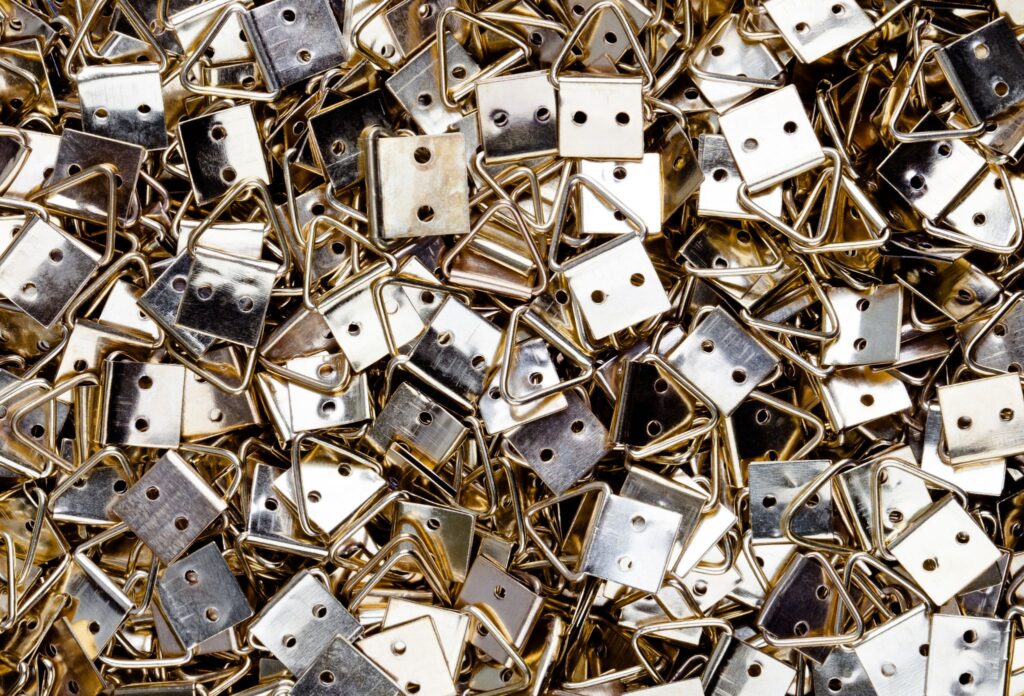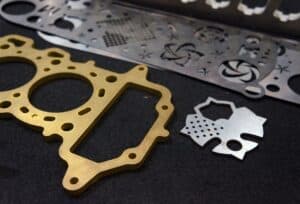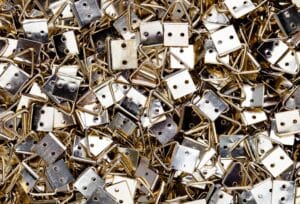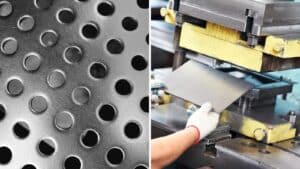Progressive stamping is a technique used in the manufacturing industry that has revolutionized the way many metal products are produced. This process, which involves the progressive forming of metal sheets through a series of sequential operations, is a key component in the production of parts for numerous industries.
At Bericht we are experts in the manufacturing of metal parts for various sectors. We are very familiar with this manufacturing technique, and in this post we explain it clearly.
What is progressive stamping?
Progressive stamping is a highly efficient manufacturing process used to transform metal sheets into complex and precise components. In this method, a strip of metal is fed through a series of stamping stations where various forming operations are performed, such as cutting, bending, drawing, and punching.
Each station performs a specific task, and the blank piece gradually moves through the set of tools to complete the process. This sequence allows for the mass production of components with tight tolerances and intricate geometries, making it an ideal option for manufacturing parts in numerous industries.
The progressive stamping process
The progressive stamping process consists of several phases that allow for highly efficient and cost-effective production of complex metal parts.
It involves a series of coordinated operations carried out in a progressive stamping press.
- Cutting: this stage involves trimming the metal sheet to form the blank piece with the required general shape.
- Bending: in this phase, mechanical forces are applied to bend the sheet at specific angles, shaping the part according to the desired design.
- Drawing: a die is used to deform the sheet and create cavities or protrusions in the part, forming features like recesses, ribs, or grooves.
- Punching: holes or cuts are made in the sheet using punches and dies, allowing for the insertion of screws, rivets, or other components.
Design and operation of metal stampings
In this technique, the metal sheet is placed in a specialized press that performs a series of sequential operations. During each press cycle, parts are formed, cut, bent, drawn, and punched in a single pass.
This is achieved using a progressive die, which contains multiple workstations, each designed to perform a specific operation on the sheet. The continuous advancement of the sheet along the stations enables the efficient and high-precision production of complex parts.
Applications and industries using progressive stamping
Progressive stamping is used in numerous applications and sectors thanks to its strong capacity to produce complex metal parts efficiently and cost-effectively. From the manufacturing of automotive components to the production of appliances and electronic devices, this manufacturing technique is essential in many industries.
- Automotive: used to manufacture parts such as body panels, chassis components, engine mounts, and internal vehicle parts.
- Home appliances: used to produce metal parts for washing machines, dryers, refrigerators, ovens, and other household appliances.
- Electronics: applied in the production of device casings, connectors, printed circuit board supports, and other metal components used in electronics.
- Aerospace: used to manufacture components for aircraft and rockets, including structural parts, brackets, and system components.
These are just a few of the applications and industries where this manufacturing method plays a vital role in producing high-quality, precision metal parts.
Advantages of progressive stamping in manufacturing
This process offers a series of significant advantages in the manufacturing of metal parts. This technique, which involves the transformation of metal coils into complex components through a series of sequential stamping operations, provides numerous benefits for manufacturing companies.
- High production speed: enables the production of large quantities of parts in a short time, increasing efficiency and productivity on the production line.
- Reduced costs: due to its ability to mass-produce parts quickly and efficiently, it helps lower manufacturing costs compared to other production methods.
- Precision and consistency: ensures dimensional accuracy and consistency of the manufactured parts, resulting in high-quality products with tight tolerances.
- Design flexibility: it is possible to create different shapes and complex geometries, allowing adaptation to the specific design requirements of each application.
- Less material waste: this manufacturing method minimizes material waste, as it efficiently uses metal coils and reduces the need for additional machining.
- Improved strength and durability: parts manufactured through this process often have greater strength and durability due to the compression and hardening that occurs during stamping.
Progressive stamping offers a range of significant benefits that make it an attractive option for metal part manufacturing in various industries. From high production speed and reduced costs to precision and design flexibility, this technique provides key advantages that improve manufacturing efficiency and quality.
These benefits make it an ideal option for companies looking to optimize operations and obtain high-quality products efficiently.
Frequently Asked Questions about Progressive Stamping
1. What types of metals can be used in progressive stamping? Progressive stamping can be used with a variety of metals, including steel, aluminum, copper, brass, and other non-ferrous metals. The choice of material depends on the specific application and the required properties of the final component.
2. What are the differences between progressive stamping and other metal forming methods? The main difference lies in the efficiency and ability to produce complex parts in high volumes. Unlike other methods such as machining or simple stamping, progressive stamping allows multiple forming operations to be performed in a single pass through the press, reducing production times and costs.
3. What factors determine the accuracy of parts produced through progressive stamping? Part accuracy depends on several factors, including the quality of stamping tools, correct press configuration, material feed control, and operator expertise. Additionally, regular maintenance of tools and equipment is crucial to maintaining consistency and precision.
4. What kind of maintenance do progressive stamping tools require? Progressive stamping tools require regular maintenance, including cleaning, lubrication, and inspection for wear or damage. Sharpening cutting edges and calibrating dies are also necessary to ensure ongoing part quality and accuracy.
5. What advantages does progressive stamping offer in terms of sustainability? Progressive stamping is an efficient process that minimizes material waste by effectively using metal coils and reducing the need for additional machining. Moreover, the ability to produce high-quality, durable parts contributes to sustainability by reducing the frequency of replacements and waste.
6. What are the limitations of progressive stamping? Although progressive stamping is highly efficient, it has some limitations. The complexity of parts is limited by the capabilities of the tools and the press. Additionally, the initial cost of designing and manufacturing progressive dies can be high, making this method more suitable for mass production rather than small batches.
These questions and answers can help your readers better understand the progressive stamping process, its applications, advantages, and limitations.




